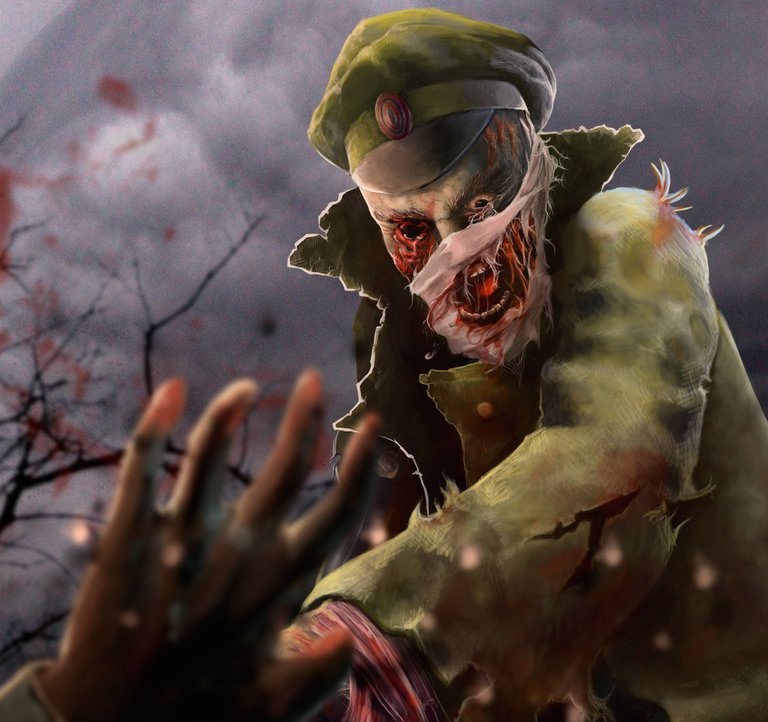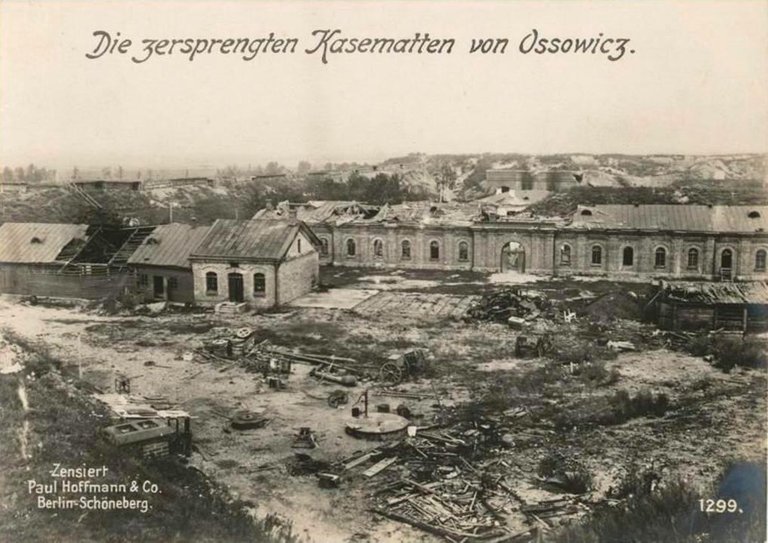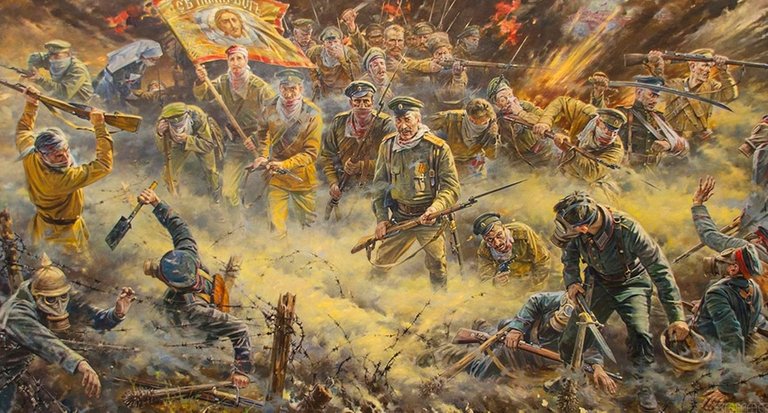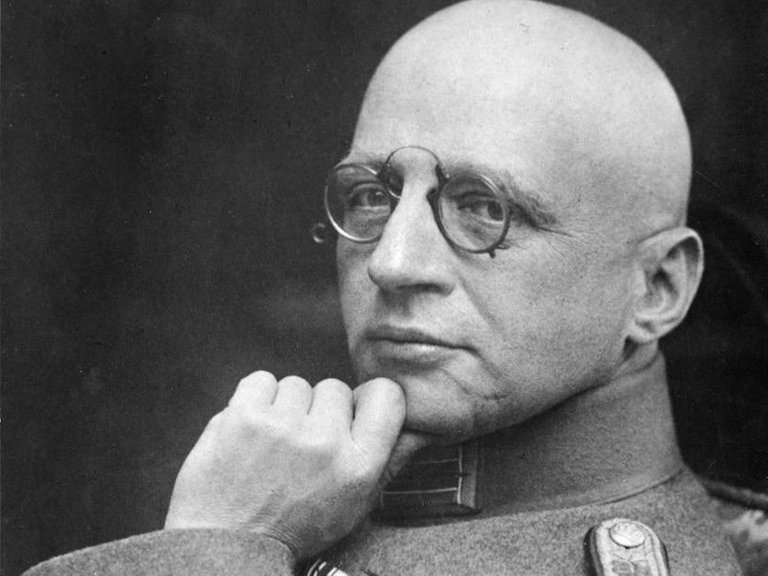
source: http://geniusloci.io/content/ataka-mertvetsov
Overview:
The "Walking Dead" of World War I, the Russian "zombie" army, played a pivotal role in aiding the Russian retreat from Fort Osowiec following a devastating chemical attack carried out by the German Army in early August 1915. In July, German troops began an all-out offensive against the Russian defensive fortress Osowiec, which was located then near the East Prussian border in what is present-day Poland. The Germans, who had attempted to break the defenses at Osowiec Tower twice before (September 1914 and February-March 1915), opted to use chemical weapons (chlorine and bromine) against the fortress defenders knowing that Russian troops did not have gas masks. Osowiec Fortress in 1915 - source: http://podlaskie.fotopolska.eu/244943,foto.html
Osowiec Fortress in 1915 - source: http://podlaskie.fotopolska.eu/244943,foto.html
On August 6 at 4 a.m., favorable conditions allowed the Germans to deploy 30 gas batteries during an artillery attack on Russian defenses. It was reported that the Russians suffered heavy losses from the toxic gas, including all the troops from the 9, 10, and 11th companies of the 226th Infantry Regiment Zemlyansky. However, not all the Russian troops immediately perished due to the effects of the poisonous gases. Led by Sub-lieutenant Vladimir Karpovich Kotlinsky, around 100 Russian troops from the 8, 13 and 14th companies, who were suffering from the effects of the asphyxiating gas, managed to launch a surprise counterattack against some 7,000 Germany infantrymen, who had advanced on and now occupied the trench positions that were burned during the chemical attack.
The Russians appeared to be zombie-like or “dead men”
According to accounts of the incident, the Russian troops who charged the German-occupied trenches scared the German soldiers due to the effects of the toxins. The Russians appeared to be zombie-like or "dead men". They had traces of chemical burns on their faces, which were wrapped in bloody rags, and repeatedly coughed up blood and spit up pieces of lungs as they suffered from asphyxiation. Between their grotesque appearance and their bayonet charge against German lines, the Russian "zombie" army managed to drive back the Germans while the rest of Russian Army retreated from Fortress Osowiec. According to popular accounts, the attacking Russians yelled out "Hooray!" or other battle cries as they charged German forces. The Russian “zombie” army allowed for Russian artillery to recover and attack German positions. Many of the 7,000 retreating German soldiers got caught in wire entanglements near the second trench line. Remaining Russian batteries fired upon the Germans and many died from shrapnel wounds while caught in that trench. The Russians proceeded to evacuate and remove the artillery from the fort before blowing up the castle later that August, which also surprised the German attackers.
 Painting from Pavel Ryzhenko, "We are Russians, God is with us!" The painting is dedicated to the "Attack of the Dead" in defense of the fortress Osovets
Painting from Pavel Ryzhenko, "We are Russians, God is with us!" The painting is dedicated to the "Attack of the Dead" in defense of the fortress Osovets
Background:
On June 28, 1914, Archduke Franz Ferdinand, the heir to the Austro-Hungarian Empire, was assassinated in Sarajevo, which the Austro-Hungarians blamed on the Serbian government. After the Austro-Hungarians declared war on Serbia on July 28, mainly in a bid to regain control of Serbia, Russia began to mobilize for war to defend Serbia, which caused another Central Power, Germany, to declare war on the Russians on August 1. Russia entered into World War I to defend Serbia, but mainly in the attempt to maintain/defend their status as an empire and Great Power of the world. As a result, Russia’s initial wartime strategy was defensive, although territorial gains were still an objective for Csar Nicolas II.
 The bloodstained uniform of Archduke Franz Ferdinand of Austria, being displayed sometime after the assassination that started the First World War. source: https://www.gettyimages.com/detail/news-photo/franz-ferdinand18-12-1863-archduke-of-austria-estecrown-news-photo/541065501
The bloodstained uniform of Archduke Franz Ferdinand of Austria, being displayed sometime after the assassination that started the First World War. source: https://www.gettyimages.com/detail/news-photo/franz-ferdinand18-12-1863-archduke-of-austria-estecrown-news-photo/541065501
Warfare between Russia and the Central Powers became known as the Eastern Front of World War I. As the first large-scale industrialized war, World War I proved to be a war of attrition, firepower, and industrial output. Within the first year of the war, one million Russian soldiers were killed, wounded, or captured on the Eastern Front. Indeed, the Russians suffered heavy losses and defeats in Eastern Prussia to Austro-Hungarian and German forces, a setback that at least drew German forces from the Western Front. The Russians also had particular difficulties transporting their troops to the Eastern Front compared to their German adversaries. At the time, Russian trains simply could not support the number of troops mobilized for war and Russian troops, on average, had to travel three times further to reach the frontlines. Because of the lack of transportation, including motorized vehicles, Russian troops stationed in Central Asia took up to two months to reach the Eastern Front.
The Russians eventually withdrew from World War I before its ultimate conclusion because of the Russian Revolution of 1917 and the removal of Csar Nicolas II from power. Although Russia and Germany were locked in a virtual stalemate by 1917, the Russian economy struggled to keep up with the costs of war, and food shortages led to civil unrest and the creation of a Russian Provisional Government that forced Nicolas to abdicate. The Bolsheviks, who eventually overthrew the Provisional Government, wanted to end Russia’s participation in World War 1. On March 3, 1918, the new Bolshevik government of Soviet Russia and the Central Powers signed the Treaty of Brest-Litovsk.
The Birth of Chemical Warfare:
By 1914, war technologies had greatly advanced. Infantrymen could fire ten times faster and from a further distance than they could one hundred years before. Field guns fired shells from a great distance filled with high-explosive shrapnel or, as in the case of the third attack on Fort Osowiec, toxic gas. The Russians were actually very familiar with industrialized warfare and the increasing size and scale of modern-day battles. The Russo-Japanese War of 1904-5 introduced the widespread use of machine guns, quick-firing artillery, barbed-wired fences, and large-scale defensive systems (i).
The rise of World War I led to the birth of 20th century chemical warfare. Fritz Haber is the man commonly associated with the creation of chemical weapons that were used in contemporary warfare. Germans quickly put the chemical weapons developed by Haber, who firmly believed that chemical weapons were more humane than modern-day artillery, to use in both the Western Front and Eastern Front. On April 22, 1915, German soldiers carried out the first wartime gas attack against French troops occupying the trenches near Ypres, Belgium. The unprepared French troops watched in terror as a greenish-yellow fog appear overhead after the Germans unleashed nearly 6,000 gas cylinders of chlorine gas, which killed more than 1,000 and injured around 7,000 Frenchmen. The Germans had previously attempted to release the irritant xylyl bromide on Russian troops in January of 1915, but extremely cold conditions stopped the liquid from vaporizing and harming the Russians. The Germans would continue to developed and use chemical weapons against the Allied Powers throughout the remainder of the war, including phosgene and mustard gas. The British, in particular, began to counter the Germans by using chemical weapons of their own. As a result, the chlorine and bromine attack of the Russians stationed at Fortress Osowiec was in the process of becoming a common occurrence in contemporary warfare (ii).
 The man who invented chemical warfare - Fritz Haber - source https://global.handelsblatt.com/politics/fritz-haber-german-invented-chemical-weapons-913625
The man who invented chemical warfare - Fritz Haber - source https://global.handelsblatt.com/politics/fritz-haber-german-invented-chemical-weapons-913625
"Dead Men Attack" or "Attack of the Dead Men": Beyond the Facts
The story of the defense of Fortress Osowiec contains a mixture facts, myths, and legends. There appears to be some confusion over whether the attack occurred in the morning of August 6th or 7th. Popular accounts that I have found while researching this event usually emphasize that European newspapers called it "the attack of the dead men." Another source argues that a 1924 Russian account of the event never refers to “dead men”(iii). One scholarly article I have consulted for information of the event is titled "Dead Men Attack," which points out that it is easy to forget that artillery fire also supported the Russian "zombie" soldiers. Moreover, it would have been difficult for many of the soldiers to let out a battle cry due to damaged respiratory tracts (iv).
In early September 1915, a New Zealand newspaper received a report on the "attack of the dead men" and the fall of Osowiec. According to that source, the Germans dropped around 600 balloons filled the toxic gases that led to the asphyxiation of the Russian soldiers. The author praised the truly “superhuman” efforts of the animated officer, presumably Sub-lieutenant Vladimir Karpovich Kotlinsky, in driving back the enemy with bayonets (v). I have also come across a Fortress Osowiec legend. Apparently, years later a journalist named Sergey Smirnov heard about a story involving a Russian soldier that lived underground below the rubble and ashes of Osowiec after the Russians blew up the castle for nearly ten years. According to Smirnov’s information, Polish officials went to Osowiec to survey the damage in 1924 before unearthing the lone survivor of the destruction of the fortress. The Russian soldier supposedly subsisted on the abundance of rations intended to support an entire company(vi). Smirnov, however, was unable to complete his investigation into the story of the underground Russian soldier. There are also a few youtube videos recounting to story of Russian "dead men" of Osowiec. The defense of Fortress Osowiec certainly remains a relatively unnoticed episode in the history of the Eastern Front and World War I.
Thanks for reading and hope you enjoyed the post.
i) Nicholas Murray, The Rocky Road to the Great War: The Evolution of Trench Warfare to 1914 (Lincoln: University of Nebraska Press, 2013), chapter 4.
ii) https://www.sciencehistory.org/distillations/magazine/a-brief-history-of-chemical-war
iii) https://bshistorian.wordpress.com/2016/02/14/attack-of-the-dead-men-1915/
iv) Alexander А. Cherkasov, Alexander А. Ryabtsev, and Vyacheslav I. Menjkovsky, “Dead Men Attack (Osovets, 1915): Archive Sources Approach,” European Researcher, no.12 (15) (2011).
v) New Zealand Herald, September 6, 1915, Volume LII, Issue 16015, National Library of New Zealand. https://paperspast.natlib.govt.nz/newspapers/NZH19150906.2.97.1
vi) http://earth-chronicles.com/histori/accidentally-forgotten-soldiers.html; http://csef.ru/en/politica-i-geopolitica/423/bessmennyj-chasovoj-devyat-let-pod-zemlej-6164
Further Readings:
David R. Stone, The Russian Army in the Great War: The Eastern Front, 1914-1917. Lawrence: University Press of Kansas, 2015.
Neil Faulkner, A People’s History of the Russian Revolution. Pluto Press, 2017.
Mary R. Habeck, Geoffrey Parker, and Jay Winter, eds., The Great War and the Twentieth Century. New Haven: Yale University Press, 2000.
I am trying to make a series of weekly posts regarding unknown and strange historical facts of the 20th century. If you like this post and want more please comment below. If anyone has a suggestion on a certain event please let me know. Thanks.
Доброго времени суток. сегодня я хочу рассказать о новой соц. сети, которые выплачивает реальные деньги. Jugl была разработана Германскими умельцами в 2017 году, за этот небольшой отрывок времени уже набрала немаленькую аудиторию. И так давайте разберемся за что же она платит. Во первых как и все начинающие проекты там есть реферальная система-за каждого человека приведенога вам по вашей реферальной ссылке вы получаете 100 Jugl монет которые равняются 1 евро, кто то скажет что это мало, на первый взгляд может быть и так но также вы можете получать У вас нет прав для просмотра скрытого текста. Вы не можете ответить в тему Перейти к первому непрочитанному сообщению м, но на этом и построена взаемовыгода всей сети, даже если вы попытаетесь зарегестрироваца самостоятельно, вас все равно подкинут какому то немцу, который не сможет помочь не зная вашего языка. Поэтому я оставляю свою реферальную ссылкуhttps://jugl.net/registration/index?refId=209668по которым я смогу помочь вам разобраться и отвечать на вопросы на русском языке. Еше один неплохой заработок здесь ето посты и лайки, как я говорил ранее здесь очень развита взаимовыгода, то есть если вы захотите и лайкаете других то и они в 80% вы ответят, таким образом каждые сутки в 1.25 по МСК на ваш счет приходят монетки за активность. Также здесь хорошо развита выплата за просмотр рекламных роликов и простых объявлений, за это действие монетки начисляются мгновенно на ваш счет. Вывод средств производится на банковские карты VISA или MASTERKARD ну или же на PAYPAL выбор остаеца за вами. минимальная сума для вывода составляет 5000 монеток что равно 50 евро, срок перевода в течении 4 дня. Еше один плюс этой монетки ето то что ее можно и использовать на долгосрок, так как проект еше молодой но уже по мировой аудитории видно что перспективный при выходе на биржу монетка неплохо возрастет. И так кому было интересно, кто решил попробовать что то новенькое и перспективное прошу регестрируйтесьhttps://jugl.net/registration/index?refId=209668 не стесняйтесь и задавайте вопросы.
please don't spam